Artisan Embroidery: Lucia LaVilla-Havelin
Our last article in the artisan embroidery series is a bit of a special one – the series has allowed us to explore some wonderful stitched art, but it also led us to discover our next artist, Lucia LaVilla-Havelin. Lucia is one of our very own The Thread readers and for the last few years has stitched’ her beautiful pieces on to The Fabrics Store‘s’ linen.
Lucia’s work is truly one of a kind – she’ explores science, nature and interaction of humans with the natural world as well as environmental issues, currently focusing on the effects of climate change to our planet. From a series on endangered species to cocktail napkins featuring viruses her art is quirky and meaningful. We wanted to find our more about her and where the inspiration for her work comes from so we asked her a few questions.
Tell us a bit about yourself – where are you from and what do you do?’
I was born in Rochester, New York and lived there until my mid-thirties when my husband’s job took us to New York City. ‘ Before leaving Rochester, I ran a large art center with multiple exhibition spaces. The Village Gate Art Center was a 16,000 sq. ft. industrial space which I was invited to turn into a gallery. ‘ I designed the exhibition spaces, developed artists’ contracts and mounted 31 shows in the first year. ‘ When we moved to New York, I worked as Associate Director of Pace Primitive, part of Pace Gallery specializing in authentic, museum quality African art from the 19th and early 20th centuries. From New York, we moved to Cleveland, Ohio and finally to San Antonio, Texas. While I was working, I continued stitching as much as possible. From Cleveland on, I have devoted myself solely to my work. ‘ About 11 years ago, we moved from San Antonio to Lytle, a small city 25 miles southwest of San Antonio – here we are surrounded by nature and I have a wonderful studio in a big red barn.
HELICATIS.’ Needlepoint canvas, cotton thread,’ glass and mother-of-pearl beads,’ Indian Dupioni silk, brass mesh, wire. Photo: Lucia LaVilla-Havelin.
What led you to embroidery?
As a child, my mother taught me how to embroider, knit and sew. She made all of our clothes when we were children, and she was a great knitter all her life. ‘ In the mid-seventies, my soon-to-be husband bought me my first loom and the lessons to go with it. ‘ I moved on from a small table loom to a large 45 inch one, weaving as a profession for about 4 years. ‘ In 1980, I concluded I needed to give up weaving. ‘ I kept injuring my back and also had other health problems. ‘ My loom and my studio had become a large part of my identity, and it was painful to let it go. ‘ I tried to think of what else would make me happy. ‘ I had been an exchange student in Copenhagen, Denmark when I was in college. ‘ I remembered all the quiet, peaceful times I had spent doing cross-stitch in solitude while there. (My Danish “mother” was a cross-stitch fanatic and got me started.) ‘ That’s when I chose needlepoint as my medium. ‘ I used an 18-count canvas (close to petit-point), to be able to get the finest images. ‘ From 1980 to 2013, I worked in needlepoint, creating everything from abstract, geometric designs, to images of goddesses, to autobiographical images and finally to 3-dimensional sculptures of underwater marine species. ‘ I particularly loved working with the sculptural forms, however, health again caused me to make a change. ‘ In 2012, I had a complete shoulder replacement in my right shoulder. ‘ Since then, the motion of pulling the thread outward through the needlepoint canvas has caused pain. ‘ That is when I turned exclusively to embroidery.
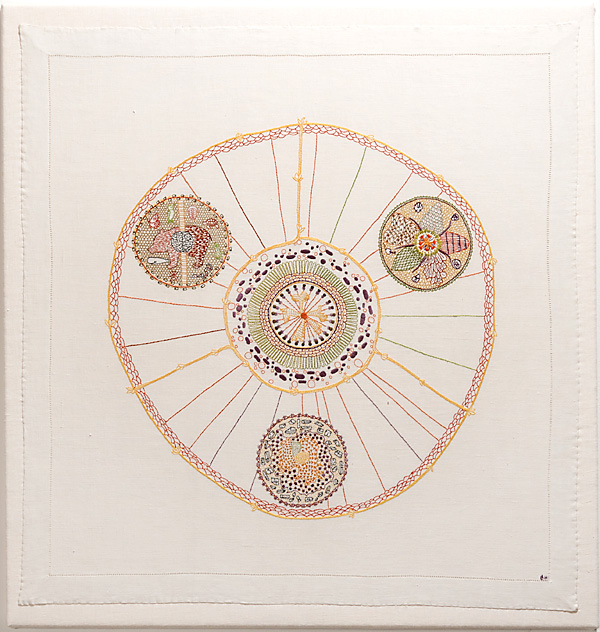
Vintage linen tablecloth hand-stitched with cotton floss from’ Animal, Vegetable, Mineral. Photo: Lucia LaVilla-Havelin
How has your work evolved over the years?’
Even with some of my early geometric and abstract forms, political awareness and commentary was there, which is still an element of my work today. ‘ I also focused on female strength and spirituality with the goddess and autobiographical pieces. These and my ‘ own health issues have led me to an interest in human anatomy, from the body to a fascination with cell structure. ‘ In 2004-5, I did three large pieces, The 3 Rs, focusing on man’s connection with nature (Reciprocity), my dad’s lung cancer (Reckoning), and the eye (Reflection). ‘ These pieces were needlepoint. ‘ In 2009-11, I made Under My Skin, a vintage linen tablecloth embroidered with close-up sections of bodily cells, and also’ Viral Cocktail and Bacteriology. ‘ And just ‘ recently in 2014, I stitched Progressions which is images the process of cell changing. ‘ With my endangered and extinct animals, I am touching not only on science, but the issue of global warming. ‘ My themes of anatomy, nature, science and politics have appeared in my work throughout the years. ‘ They are still important to me, but I believe the way I approach these subjects will continue to evolve and grow.
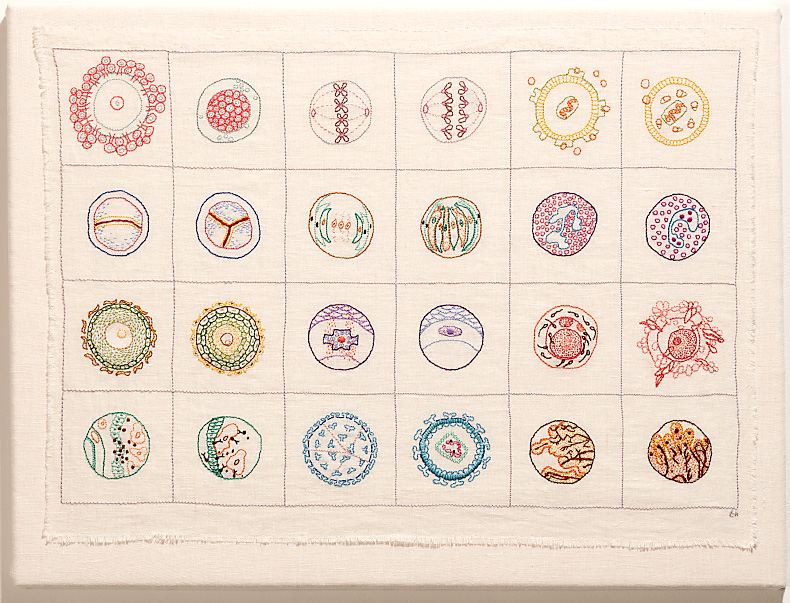
PROGRESSIONS, a’ series of processes in the human body at the cellular level.’ Linen fabric hand-stitched with cotton floss. Photo: Lucia LaVilla-Havelin
Do you see this’ focus on the natural world ever changing?
Living in a rural area, with cows on one side of me, horses on the other, snakes, hawks etc., I ‘ think the natural world will always be present in my work. ‘ My husband and I are amateur bird watchers, so birds seem to always be present in my work too. ‘ But there will always be other interests, images etc. that will inspire me.
LANDFORMS,’ needlepoint and beading on silk. Photo: Lucia LaVilla-Havelin
Do you ever have artistic blocks? How do you overcome them?
I always like to work in series, and I need some type of narrative that will keep me interested through several pieces. ‘ I do research and collect books that inspire me. ‘ So, sometimes, when I finish a series, I don’t have another idea percolating. ‘ It can feel very frustrating since I am someone who wants to work all the time. ‘ I turn to my books, and the art books my husband and I own, and browse through them. ‘ You have to give it time, and before you know it, another idea appears.
READ INTO: PRAYER WHEEL, SUNDIAL, TURTLE. Linen and silk fabric hand-stitched with cotton floss, nylon thread, coral and glass beads. Photo: Lucia LaVilla-Havelin
You’ve done a couple of collaborations, what did they mean to you?
I loved collaborating. ‘ Years ago I collaborated with a metalsmith friend, and she set some of my small needlepoints into silver pins and pendants. ‘ I often collaborate with my husband, a poet. ‘ I stitch a poem, or part of a poem and create an image to compliment the words. The most recent collaboration was with Melanie Rush Davis, a photographer. ‘ She printed some of her images on cloth and I embroidered over them. ‘ It was challenging and exciting. ‘ I wanted to do her work justice, yet put my own stamp on the pieces. ‘ It took a lot of thought, but we both are very pleased with the result and will do more.
UNDER MY SKIN. Vintage linen tablecloth, cotton thread.’ Photo: Lucia LaVilla-Havelin.
What does your art mean to you?
Other than my husband, my art is the most important thing in my life. ‘ It is who I am. It is what I do. ‘ It is what I have to do. ‘ It is centering and peaceful. ‘ I love the solitude of it. ‘ It challenges me. ‘ It makes me think and grow. ‘ I do it for myself and hopefully, it pleases others and brings beauty and thoughtfulness into their lives.
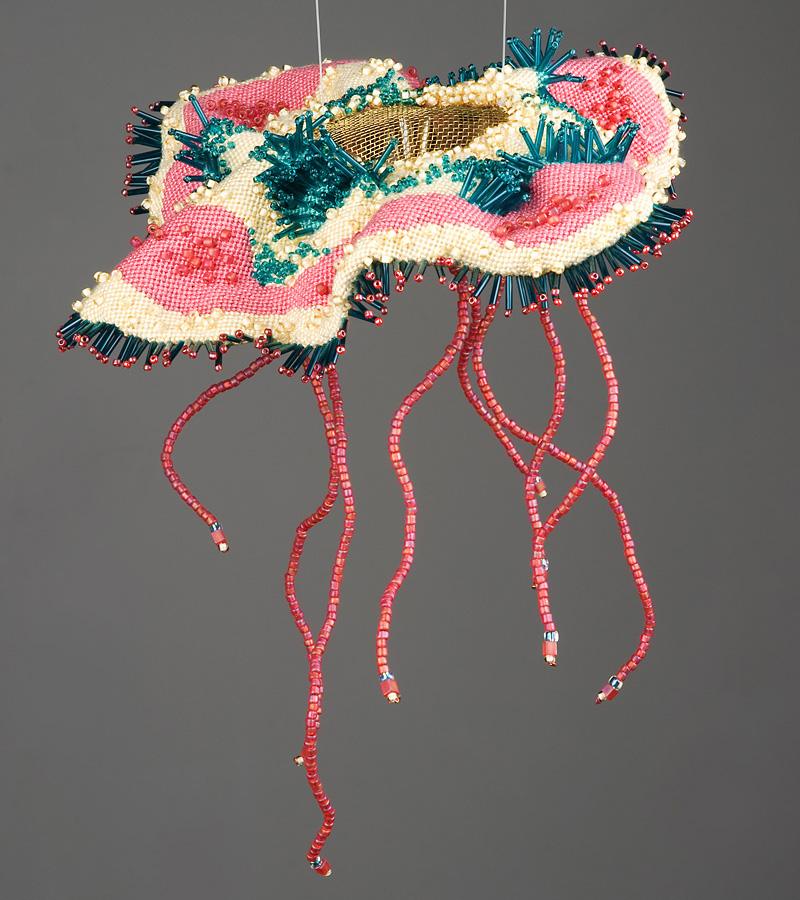
RHIZARIA II.’ Needlepoint canvas, cotton thread,’ glass and mother-of-pearl beads,’ Indian Dupioni silk, brass mesh, wire. Photo: Lucia LaVilla-Havelin.
What advice do you have for upcoming’ artists?
Do your work for yourself. ‘ Do what feels right to you. ‘ Don’t make pieces because you think they might sell. ‘ I know all of us need to make a living, but if you aren’t true to yourself and who you are, it will show and the work will not be true. ‘ Trust yourself.





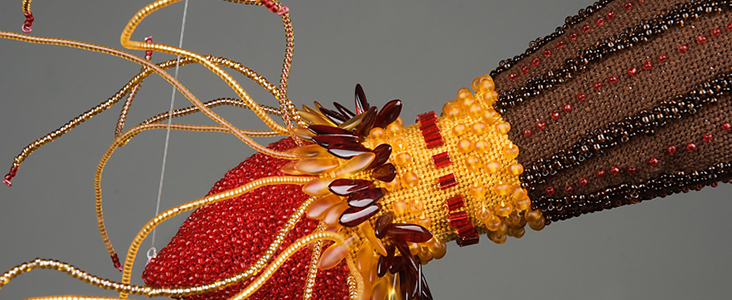
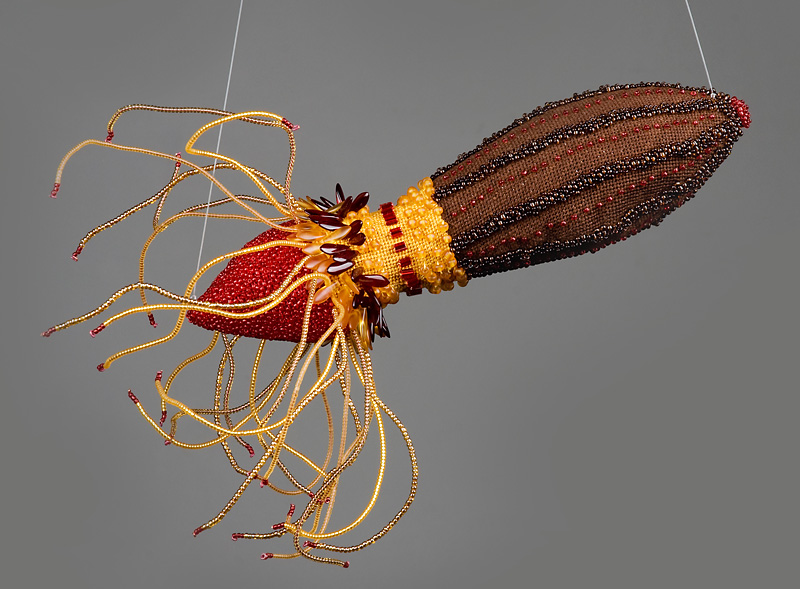
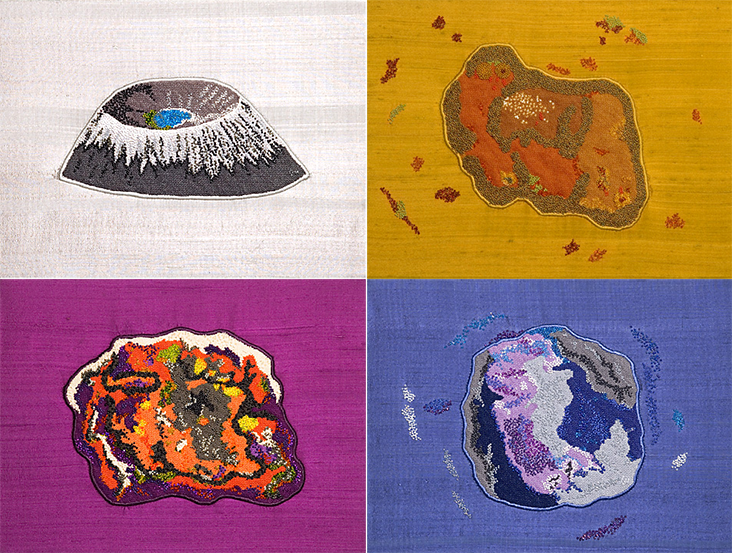
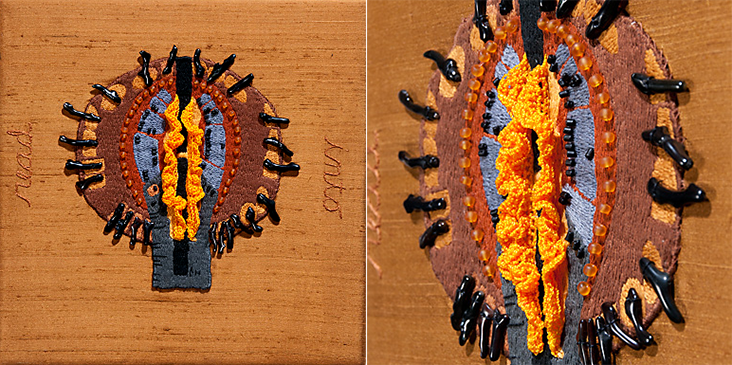
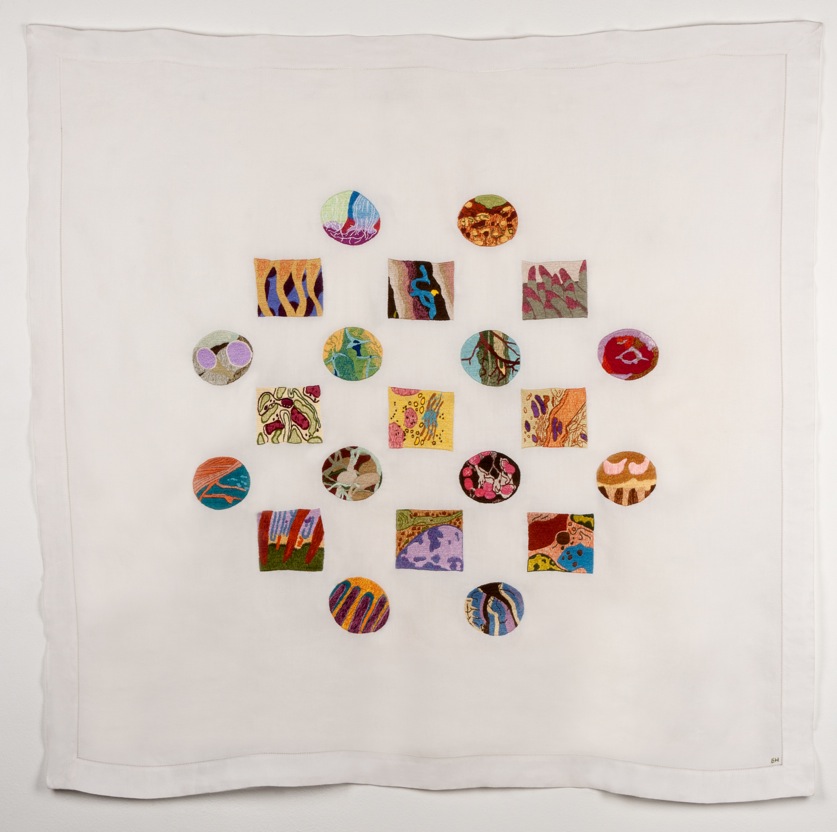
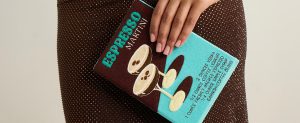
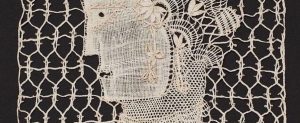
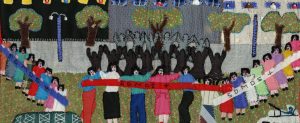
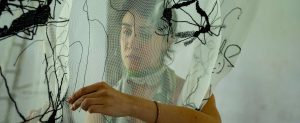
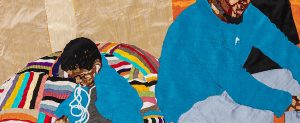









































2 Comments
Marilyn Cleland
What beauty. I envy those who do this — work with their hands to create. My grandmother taught me to crochet and to make potholders, both of which made me happy. My grandmother was a fabric artist. But, reading was my true love then and academic life was for me. Now, at the age of 75, I am pursuing creating through poetry, painting, and piano. Except for the piano, I am new to the others. And I do find working with fabric so rewarding. I see from your work that I can use stitching as I do paint. And I am going to try.
To all those who let a reading child do only that, I urge you to train your child to work with their hands early on. It is a lifelong gift. — Marilyn Cleland
Elizabeth Schnelle
It is articles and pictures of what other artists do and share that keeps me and some of my artist friends motivated AND SO APPRECIATIVE if their sharing. Thanks